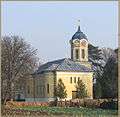Glogonj
| Glogonj Глогоњ | ||
|---|---|---|
| Village | ||
| ||
 Glogonj Location of Glogonj within Serbia | ||
| Coordinates: 44°59′N 20°32′E / 44.983°N 20.533°ECoordinates: 44°59′N 20°32′E / 44.983°N 20.533°E | ||
| Country | Serbia | |
| Province | Vojvodina | |
| District | South Banat | |
| Population (2011) | ||
| • Glogonj | 3,012 | |
| Time zone | UTC+1 (CET) | |
| • Summer (DST) | UTC+2 (CEST) | |
| Area code(s) | +381(0)13 | |
| Car plates | PA | |
Glogonj (Serbian Cyrillic: Глогоњ ![]()
History
Topographic history
In 1911, the Orthodox church Assumption of Lord's Mother was built. Before completion of the church, the Orthodox residents had to go to the church of the competent parish community in Sefkerin.[1]
Demographic history
In 1936, the new local group of the Schwäbisch-Deutscher Kulturbund was found by Germans. The member Michael Lang became leader of local echelon of paramilitary Deutsche Mannschaft of the regional Einsatzstaffel Hermann Göring (operation echelon Hermann Göring). During the Belgrade Offensive by Allied Armies, first troops of Soviet Red Army arrived in the village on 4 October 1944.[2][3]
On 30 October 1944, 127 Germans were killed by shooting near the floodplains next to the road to Opovo by Special commands of Yugoslav Partisans. The number had a symbolic one. 100 persons were representative for the escaped First-rate officials of national socialist organization of Danube Swabians. 27 persons were representative for the same number of killed persons of about 3,600 prisoners from Bor. The prisoners had to camp there during the day until dusk. Members of Hungarian guards and paramilitary Deutsche Mannschaft killed them by hitting because they tried to get river water for drinking despite the ban. An interviewed eyewitness indirectly named this event only. He did not mention the place of action. He did not even mention all of the facts that happened then. But he described this event with the word watermelons. That happened on 27 September 1944. Almost all of killed Germans were young Second-rate officials from Glogonj and Opovo. The contemporary witness of a Danube Swabian publication called that area of floodplains airfield. He meant the Germans way to heaven only and mentioned nothing about the prisoners from Bor. According to that report, the parson of Glogonj was killed in the village center. However, it was the most prominent man of the Gross family, who became appointed German mayor of Sefkerin during the time of Autonomous Banat. The village was and is mostly populated by Serbs. The tortured man was publicly hanged to the tower of fire brigade on 4 October 1944.[4][5]
Historical Population
- 1961: 3,230
- 1971: 3,257
- 1981: 3,605
- 1991: 3,475
- 2002: 3,178 (2,400 Serbs, 927 Romanians, 367 Macedonians and 255 Others)
Notable Citizens
Adolf Schagar, Julius Jelić and Béla Bazarabić, young members of Theresian Military Academy since 1836, 1878 and 1884.[6]
Mathias Benrád and Nikola Zseravić, exhibitors of agricultural products (seeds of papaver and cereal) at the World Exposition of 1873.[7]
Lajos Szekrényi, translator of some works by Karl May into Hungarian.[8]
Stephan Scharinger, at least school caretaker in Jabuka, innocent victim of lynching.[9]
Franz Lischitz, a young member (horse keeper) of the SS Freiwilligen Gebirgsjäger Division Prinz Eugen strictly refused his first participation in a reprisal in the area around Sarajevo. He was shot and killed because of his command denial on 10 October 1943.[10]
Articles
Image Gallery
 Romanian Orthodox Church Assumption of Lord's Mother
Romanian Orthodox Church Assumption of Lord's Mother
References
- ↑ Hof- und Staats-Handbuch der österreichisch-ungarischen Monarchie für 1877, Vienna 1877, p. 828 on Google Books.
- ↑ Bundesleitung des Schwäbisch-Deutschen Kulturbundes, Die Arbeit des Kulturbundes 1938: Liste aller regionalen Ortsgruppen als Beilage (Enclosing list of all new regional local groups), Tätigkeitsbericht vom 20 November 1937 – 1 December 1938, Druckerei- und Verlags-A.G., Neusatz 1938.
- ↑ Franz Lang, Mit uns in Glogonj! 1767-1945, Karlsruhe 1990, p. 12–13, 109-112.
- ↑ Randolph L. Braham, The Politics of Genocide. The Holocaust in Hungary. Volume 1, Columbia University Press, New York City 1981, ISBN 0-231-05208-1, p. 335-359. Interview for his research with Josef Žsivaj (pseudonym of Iosif Clivaj), brother of the second husband Heinrich Čivaj of Theresia Richardt (7 November 1909, Jabuka, Serbia – 27 July 1993, Vienna, Austria).
- ↑ Donauschwäbische Kulturstiftung (Danube Swabian Culture Foundation), Leidensweg der Deutschen im kommunistischen Jugoslawien. Band 2: Erlebnisberichte über die Verbrechen an den Deutschen durch das Tito-Regime in der Zeit von 1944-1948, Munich 1993, ISBN 3-926276-17-7, p. 175-176.
- ↑ Johann Svoboda, Die Theresianische Militär-Akademie zu Wiener-Neustadt und ihre Zöglinge von der Gründung der Anstalt bis auf unsere Tage. Volume 2, k. u. k. Hof- und Staatsdruckerei, Vienna 1894, p. 90, 735 and 792 (Google Books; German), retrieved on 2017-12-18.
- ↑ Officieller General-Catalog der Weltausstellung, Wien 1873, p. 169 on Google Books.
- ↑ Article on Lajos Szekrényi in Karl-May-Wiki (German), retrieved on 2017-12-18.
- ↑ Local cemetery, Grave No. 98.
- ↑ Franz Lang, Mit uns in Glogonj! 1767-1945, Karlsruhe 1990, Enclosing original map of former families and households in 1944: Franz Lischitz, first husband of Theresia Richardt, born on 7 November 1909, Jabuka – 27 July 1993, Vienna, Glogoner Mühl(en)gasse.
- Franz Lang, Mit uns in Glogonj! 1767-1945, Karlsruhe 1990.
Weblinks
- Glogonj on the Official Website by the municipality of Pančevo (Serbian)
| Wikimedia Commons has media related to Glogonj. |
